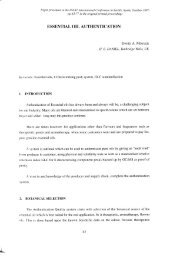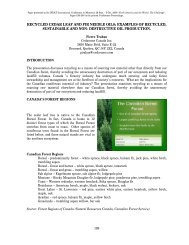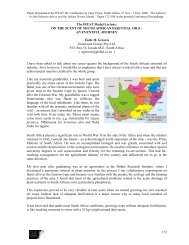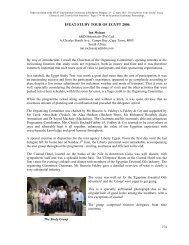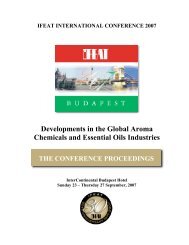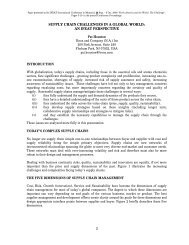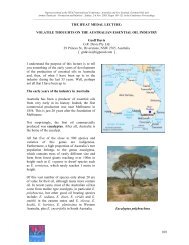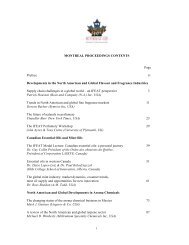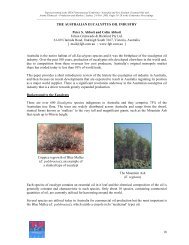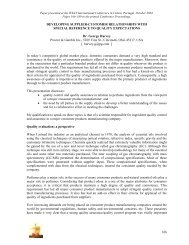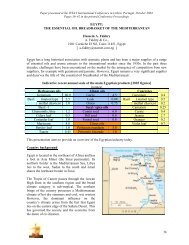HUNGARY'S ESSENTIAL OIL INDUSTRY Csaba Fodor ... - IFEAT
HUNGARY'S ESSENTIAL OIL INDUSTRY Csaba Fodor ... - IFEAT
HUNGARY'S ESSENTIAL OIL INDUSTRY Csaba Fodor ... - IFEAT
Create successful ePaper yourself
Turn your PDF publications into a flip-book with our unique Google optimized e-Paper software.
Paper presented at the <strong>IFEAT</strong> 2002 International Conference – ‘Central & Eastern Europe: A source and a market<br />
for essential oils and aroma chemicals’; Warsaw, Poland, 13-17 Oct. 2002. Pages 35–49 in the Conference Proceedings.<br />
_________________________________________________________________________________________<br />
HUNGARY’S <strong>ESSENTIAL</strong> <strong>OIL</strong> <strong>INDUSTRY</strong><br />
<strong>Csaba</strong> <strong>Fodor</strong><br />
Silvestris & Szilas Ltd<br />
Vasút u. 42, H-2144 Kerepes, Hungary<br />
[ csaba_fodor@silvestris.hu ]<br />
Hungary has a long history as an origin of essential oils. However, the industry has undergone a<br />
number of major changes over last century. My intention is to give a brief overview of the whole<br />
history of commercial production and then to focus on the more recent developments.<br />
Background on Hungary<br />
Hungary is located in the heart of Europe, and has borders with Austria, Slovakia, Ukraine, Romania,<br />
Yugoslavia, Croatia and Slovenia.<br />
Hungary and its neighbours<br />
The population is 10 million, of whom 20% live in the capital, Budapest. Since WW I, a large number<br />
of Hungarians (equivalent to more than 30% of the current total population) have been living in<br />
neighbouring countries. This has resulted in the development of special, ethnic-based trading links<br />
with neighbouring countries, which are used also in our essential oil sector.<br />
The GDP per capita was US$5,088 in 2001, which equated to about 50% of the average in the member<br />
countries of the EU, and the growth rate was around 5%.<br />
Hungary is expected to become a member of EU by 2004, and harmonization work is in hand in<br />
preparation for this step.<br />
35
Prior to 1990, Hungary was considered an agricultural economy and the main crops were wheat and<br />
corn. In the past decade, however, a large amount of foreign investment arrived in the country and<br />
changed the orientation to an industrial profile. Hungary succeeded in attracting the largest foreign<br />
investment per capita in the region up until 2001. This was due to the relatively cheap and skilled<br />
manpower resource, the advanced banking system, plus a stable economic and political environment.<br />
This inward investment trend stopped in 2002 as, probably due to the sharply increasing cost of skilled<br />
manpower, some large multinational companies moved their operations to cheaper developing<br />
countries, in several cases outside of the region.<br />
The Essential Oils Industry<br />
My discussion of the essential oil industry in Hungary examines the following time periods:<br />
• Before WW II.<br />
• The Communist era, 1945-90.<br />
• The transition period 1990-94.<br />
• The years of a market economy, 1994-2002<br />
• Future challenges<br />
Before WW II<br />
It is possible to trace the industry back to the 13 th century and the manufacture of the famous ‘Hungary<br />
(or Rosemary) Water’ but, instead, let us start with the birth of commercial essential oil production in<br />
the 1920s.<br />
The renowned Schimmel Co. of Miltitz in Germany established a subsidiary in Budapest in 1923. The<br />
company held a very strong position in supplying local users by offering a full range of aromatic<br />
products: liqueur and rum essences, essential oils, flower oils, perfume compounds and aroma<br />
chemicals.<br />
In the early 1920s, Dr. Jules Bittera introduced several new selected crops from abroad, including<br />
French lavender, English Mitcham peppermint and Dutch caraway. Next, he initiated a continuous<br />
crop selection programme to increase oil yields and qualities. As a result, the production levels grew<br />
year by year all products were exported and were praised as of very high quality (as recorded in Ernest<br />
Guenther’s The Essential Oils). Additionally, Dr. Bittera made products from wild grown plants.<br />
By 1941, production was as follows:<br />
From<br />
cultivation<br />
From wild<br />
plants<br />
Product Output (tonnes) Main producing areas<br />
Peppermint oil 8.5 Zalavár & Deáki<br />
Dillweed oil 3 Dömsöd & Deáki<br />
Lavender oil 0.6 Tihany<br />
Marjoram and caraway oils<br />
Kalocsa<br />
Juniper berry oil<br />
Oak moss extract.<br />
36
Chart 1: Production scale for the main oils<br />
in 1941 (kg)<br />
9000<br />
8000<br />
7000<br />
6000<br />
5000<br />
4000<br />
3000<br />
2000<br />
1000<br />
0<br />
Peppermint Dillweed Lavender<br />
Map 2: Distillery locations in 1941<br />
Deáki<br />
Tihany<br />
Dömsöd<br />
Zalavár<br />
Kalocsa<br />
37
The Communist Era (1945-1990)<br />
The end of WW II brought the Russians and the communist system to Hungary, and both stayed for 45<br />
years.<br />
Schimmel and Dr. Bittera’s distilleries of were appropriated by the communist regime, as were all<br />
companies in the country. In 1951, these state-owned operations were called the Kompozíció Essential<br />
Oil and Chemical Factory (and were renamed as KHV in 1962). In this organization, everything was<br />
centralized (fragrance and flavour manufacture, essential oil and aroma chemical production). It was a<br />
100% monopoly situation as no other company in the country was permitted to compete. Similarly, the<br />
only company entitled to export essential oils was state-owned, Medimpex.<br />
With the emergence of Cold War politics, the industry lost its traditional markets in the West and there<br />
was a consequent decline in essential oil production, reaching a minimum of 1.9 tons in 1954.<br />
However, this was followed by a strong recovery over the next 13 years. From 1954 to 1967:<br />
• production grew twenty-fold to 41.1 tonnes / year, (see Chart 2), and<br />
• the area under cultivation grew eight-fold from 250 ha to 2,000 ha (see Chart 3).<br />
Chart 2: Total Oil Production (tonnes)<br />
in 1941, 1954 and 1967<br />
45<br />
40<br />
35<br />
30<br />
25<br />
20<br />
15<br />
10<br />
5<br />
0<br />
1941 1954 1967<br />
The reason behind this renaissance in the fortunes of the industry also was political: the communist<br />
love for redistribution. KHV made good profits on F&F products as the regional market was protected<br />
from international competition. At the same time, many aroma chemicals needed in F&F formulas<br />
were not available in the Eastern Bloc countries and, therefore, hard currency was needed for imports<br />
from the West. This led to the state subsidies for the production of essential oils destined for export to<br />
Western markets. As a result, many cooperatives all over the country were encouraged to grow<br />
aromatic herbs and to build distilleries.<br />
38
Chart 3: Essential oil crop cultivation area<br />
(ha) in 1954 and 1967<br />
2000<br />
1800<br />
1600<br />
1400<br />
1200<br />
1000<br />
800<br />
600<br />
400<br />
200<br />
0<br />
1954 1967<br />
Map 3: Distilleries in 1967<br />
Újfehértó<br />
Kapuvár<br />
Enying<br />
Páty<br />
Papkeszi<br />
Tihany<br />
Balatonfenyves<br />
Öreglak<br />
Paks<br />
Daránypuszta<br />
Miske<br />
Székkutas<br />
Mohács<br />
There were 14 operating distilleries in 1965:<br />
• 7 operated by KHV (in Budapest, Kapuvár, Papkeszi, Paks, Miske, Mohács, Balatonfenyves),<br />
and<br />
• another 7 operated by cooperatives (at Páty, Újfehértó, Enying, Öreglak, Daránypuszta,<br />
Székkutas, Tihany).<br />
39
All distilleries delivered the oils to KHV in Budapest, where they were blended, filtered, packed and<br />
prepared for export.<br />
The oils produced in the mid-1960 were:<br />
Main products:<br />
• lavender and lavandin (8-10 tonnes)<br />
• peppermint (4-5 tonnes)<br />
• dillweed ((8-10 tonnes)<br />
• Pinus sylvestris (6-8 tonnes)<br />
Minor oils:<br />
• clary sage<br />
• tarragon<br />
• hyssop<br />
• fennel<br />
• coriander<br />
• caraway<br />
It is interesting to note that at this time the yields of almost all essential oil crops were low, usually<br />
half or one third of recent yields. The profitability of the 1960s industry in a market economy context<br />
would have been questionable, even with heavy subsidies - but it was the soviet system.<br />
Chart 4: Production of the main oils in<br />
1967 (tonnes)<br />
10<br />
9<br />
8<br />
7<br />
6<br />
5<br />
4<br />
3<br />
2<br />
1<br />
0<br />
Lavender and<br />
Lavandin<br />
Peppermint Dillweed Pinus<br />
Sylvestris<br />
In 1977 the organizational arrangements changed. One of the cooperatives (Szilasmenti) took over the<br />
business of KHV and all distillation units of several cooperatives were delivered to Kerepes, creating a<br />
huge concentrated capacity there. Additionally, exporting was transferred from Medimpex to<br />
Pharmatrade, another state owned company. This change was smooth, although production figures in<br />
the 1970s were slightly lower than in the 1960s, around 30-35 tons/year, the major crops remained the<br />
same.<br />
40
In the 1980s, total production quantities remained more or less at the same level (~ 30 tons per year)<br />
but the product structure slowly changed:<br />
• peppermint and lavender oil production went down, while<br />
• output of fennel, caraway, angelica, blue and Roman chamomile increased.<br />
Chart 5: Total Oil Production Levels (tonnes)<br />
in 1941, 1954, 1967 and 1980<br />
45<br />
40<br />
35<br />
30<br />
25<br />
20<br />
15<br />
10<br />
5<br />
0<br />
1941 1954 1967 1980<br />
The major export markets during the communist era were heavily European oriented with Germany<br />
and France accounting for 70% of the total.<br />
Chart 6: The Export Markets in the 1970s<br />
France 36%<br />
Germany 34%<br />
UK 8%<br />
USA 7%<br />
Switzerland 5%<br />
Rest 10%<br />
41
The Transition Period (1990-94)<br />
We had our first free election in 1990. Everyone was happy - the Russians had left - and the Hungarian<br />
people felt freedom and unlimited possibilities. However, the situation was not that rosy in the<br />
economy. Our new conservative government tried to find solutions but, unfortunately, their actions<br />
have not always been the best ones for the essential oils industry. The government’s programme<br />
involved:<br />
• The withdrawl of all subsidies.<br />
• A political attack on cooperatives, which were regarded as communist economy hang-overs.<br />
• Re-privatization of land.<br />
The immediate effect of the abolition of subsidies in the essential oil sector was profitability losses<br />
and, within 3 years, bankruptcy at the Szilasmenti cooperative. It was then privatized and acquired by<br />
Silvestris Ltd.<br />
Reprivatization of the land caused a tremendous problem for the whole of Hungarian agriculture:<br />
• All modern cultivation equipment was owned by the cooperatives but these were deprived of<br />
land.<br />
• The new landowners mainly held areas of only 1-2 ha and, moreover, had no intention or<br />
capability to undertake cultivation.<br />
An interesting example of the outcome is provided by the lavender plantation in Kerepes. In 1990, the<br />
plantation was just turning to the high yield stage, but the agrarian reform committee divided the land<br />
exactly crossing the rows of lavender. The Szilasmenti Cooperative tried to rent this land back, as it<br />
represented a huge investment made only a few years earlier, but this proved in vain. Some of the new<br />
smallholders decided to grow corn as feed for their pigs, so they weeded out the lavender. Eventually,<br />
the whole lavender plantation disappeared.<br />
Finally, all of the cooperatives involved in cultivation and distillation of aromatic herbs disintegrated.<br />
Distillation units were sold and, generally, everything was chaotic for 4 years.<br />
Chart 7: Hungary’s Essential Oil Exports 1984-97<br />
(US$ millions),<br />
2.5<br />
2<br />
1.5<br />
1<br />
0.5<br />
0<br />
1984 1985 1986 1987 1988 1989 1990 1991 1992 1993 1994 1995 1996 1997<br />
42
This is demonstrated by the export figures in Chart 7 for 1984-97. It reveals that 1990 was the peak<br />
year, a rapid fall occurred until 1993 (the year of privatization of Szilasmenti), afterwards there was a<br />
recovery and by 1997 exports re-attained the 1990 level.<br />
Stabilization in a Market Economy<br />
An interesting characteristic of the Hungarian essential oils industry is that always it has been<br />
dominated by one company. In the communist era, it was Kompozícó / KHV / Szilasmenti while,<br />
today, 80% of exports arise from Silvestris & Szilas. This is quite fascinating as modern Hungary<br />
apparently is following the good old soviet system in the market economy: one industry - one<br />
dominant company.<br />
Chart 8: Total Hungarian vs. Silvestris Exports<br />
from 1994-2001(US$ millions)<br />
2.5<br />
2<br />
1.5<br />
1<br />
0.5<br />
0<br />
1994 1995 1996 1997 1998 1999 2000 2001<br />
Silvestris<br />
Hungary<br />
The 20 % non-Silvestris part of Hungary’s exports are mostly comprised of re-export from the former<br />
Soviet Union and are based on the traditional links between the former Eastern Bloc countries. The<br />
largest products in this group are lavender, coriander, clary sage and fir needle oils.<br />
The essential oil production system in Hungary today has an even higher concentration than under the<br />
old regime:<br />
• 95% of the capacity is operated by Silvestris - the largest capacity (122 m 3 ) at Kerepes and<br />
another (18 m 3 ) at Nyiracsad.<br />
• Two other distilleries are run by farmers: at Szekkutas (5 m 3 ) and at Öreglak (2 m 3 ).<br />
43
The Kerepes distillery<br />
Map 4: Distilleries in 2002<br />
Nyíracsád<br />
Kerepes<br />
Öreglak<br />
Székkutas<br />
Charts 9 and 10 show that between 1967 and 2002:<br />
• the number of distillery sites decreased by 70%,<br />
• while capacity decreased only by 20%<br />
44
Chart 9: Number of Distilleries,<br />
1967 vs 2002<br />
20<br />
15<br />
10<br />
5<br />
0<br />
1967 2002<br />
Chart 10: Total Distillery Capacity (m 3 ),<br />
1967 vs. 2002<br />
200<br />
180<br />
160<br />
140<br />
120<br />
100<br />
80<br />
60<br />
40<br />
20<br />
0<br />
1967 2002<br />
However, the export markets have been changed radically. In 2000, the USA had the largest share<br />
(26%), followed by France (17%) and Germany (11%) – see Chart 11. The comparison figures for<br />
1970 and 2000 in Chart 12, illustrates the decline in the importance of the European market.<br />
45
Chart 11: The Export Markets in 2000<br />
USA 26%<br />
France 17%<br />
Germany 11%<br />
Japan 10%<br />
UK 9%<br />
Rest 27%<br />
Chart 12: Export Market Shares (%)<br />
1970 vs. 2000<br />
40<br />
35<br />
30<br />
25<br />
20<br />
15<br />
10<br />
5<br />
0<br />
France Germany USA Japan<br />
1970s 2000<br />
46
Also, there has been a significant change in the crop structure:<br />
Major crops of 1960s Major crops in 2000<br />
• Peppermint • Angelica root • Fennel<br />
• Lavender<br />
• Blue chamomile • Dill<br />
• Pinus sylvestris • Caraway<br />
• Parsley seed<br />
• Lovage<br />
• Origanum<br />
The comparative crop shares have changed every year but it is worth mentioning one important oil that<br />
influenced the country’s figures heavily between 1994-1998; namely, parsley seed. Some of you might<br />
still remember the extreme shortage and skyrocketing prices of this oil that were caused by the huge<br />
demand from US breath freshener manufacturers. This was followed by a huge overproduction that<br />
sent the prices far below production cost. This example leads to the last part of my discourse.<br />
Present and Future Challenges<br />
The essential oil industry faces general and country specific challenges.<br />
The general problems encountered by all essential oil producers are:<br />
Instable supply - Being natural products, a crop failure in a major producing country will result in a<br />
shortage, higher oil prices and, eventually, lower demand. This happened recently with our high<br />
azulene type milfoil oil, where – after 3 consecutive crop year failures in Hungary - the major users<br />
eliminated it from their formulas.<br />
Volatile demand – The parsley seed oil case is a very good example. There was a stable market: and<br />
distillers in France and Hungary used cheap non-germinating seeds for production of relatively cheap<br />
oil, which found some usage in the flavour industry. The annual world production was 1-2 tons a year,<br />
the price was stable around US$100-110 / kg and everyone involved was happy. But, in 1994<br />
American breath freshener companies created a new, immediate and huge market. They requested<br />
more than 10 tons of PSO annually. The result After eating up all existing stocks, prices skyrocketed<br />
to US$300 / kg by 1996. This oil price trend moved on to the raw material and it encouraged hundreds<br />
of farmers all over the world to plant parsley. By 1999 there was a huge supply but by that time the<br />
main user had changed the formula: reducing PSO incorporation by more than 50% as a first step and,<br />
finally, discontinuing manufacture of the brand. What had he left behind him Many essential oil<br />
distillers and dealers had large stocks of oil and hundreds of desperate farmers had huge quantities of<br />
seeds that had been begged for two years earlier but now nobody wanted the material. The result The<br />
oil price went down to US$70-75 / kg, several farmers went bankrupt and cursed parsley forever. This<br />
good old roller coaster probably will start again one day, when some new uses will be created on a<br />
delusionary low price. Perhaps we shall see soon a roller coaster developing with one of the oils from<br />
this region that has recently increased in price: coriander.<br />
Another problem is the unbalanced relationship between large F&F corporations and small raw<br />
material suppliers. Even if you can get through the painfully long process of approvals, you have filled<br />
up tons of documents and finally got a contract at a reasonable price, are you completely happy Not<br />
necessarily, if you think of the 2 years contract time and your forthcoming difficulties. You may have<br />
to get loans to finance your next production season, while you are still carrying the stock of giant<br />
corporations, from last year’s crop.<br />
47
Or, what can you do if one of your major customers is merging with another multinational, and your<br />
product is simply eliminated from the raw material list Shall we be worried again, listening to the<br />
news<br />
Legislation: I shall refrain from going into details, as there are a number of lectures during the<br />
conference dedicated to this subject. However, what can a distiller do if his customer is forced to<br />
eliminate his oil from the formula Unfortunately, several essential oils now should be considered as<br />
endangered species in the EU. Even in Hungary we have a local problem and our association is trying<br />
to fight a clever clerk in the Environmental Ministry who put a phrase into our law on Hazardous<br />
products two years ago. This regulation states that all waste material from aromatic herb processing<br />
must to be considered as hazardous material, unless otherwise proven by some very expensive tests.<br />
Now all exhausted residues of chamomile, dill, caraway, etc., formerly considered as valuable byproducts<br />
(natural fertilizers), are targets for our local agencies. It is a really crazy world.<br />
Other specific Hungarian problems include:<br />
• The strengthening of our currency (the Forint) by more than 15 % this year. This is quite a<br />
challenge considering the fact that more than 95% of the Hungarian essential oil production is<br />
exported. We have to compensate it with increased productivity, cost reductions, etc. which is<br />
not an easy job.<br />
• The lack of experienced farmers with large landholdings and cultivation equipment.<br />
• The cost of manpower is increasing sharply.<br />
Our answer to these challenges are:<br />
We will strive to develop better and better species. Sometimes the result of research is an existing<br />
crop with higher yield (as in case of fennel), or with higher contents of active ingredient (as in the case<br />
of blue chamomile with more that 10% chamazulene). Sometimes, we reintroduce traditional species,<br />
abandoned earlier due to heavy competition. Examples of this group are: lavender, coriander, tarragon,<br />
and peppermint; all were big Hungarian products in the past, are small today but any of them might be<br />
a key product tomorrow. Also, we must examine native flora that has previously never been distilled<br />
on a commercial scale; the most recent example of this work is origanum. Other research in these<br />
areas has given promising results.<br />
Reorganization of the raw material supply: To persuade and then teach farmers to grow an<br />
unknown aromatic herb is a difficult and sometimes hopeless job. They always compare the<br />
profitability with very different types of crops. Unless they see a large potential margin, they stay with<br />
their well-known annual crops, such as wheat and corn. Also, those who are already growing aromatic<br />
herbs tend to quit rather quickly at crop failure. They do not plan for long term. If you want stability<br />
you have to put some control on your raw material supply. For these reasons, Silvestris created a<br />
subsidiary to grow aromatic herb exclusively for its essential oil production in 2000. This proved to be<br />
successful in the first two years.<br />
Reorganization of production system: Eliminating manpower whenever possible, by using<br />
mechanisation in both agricultural and distillation operations. A new distillery is being established<br />
right on the field to reduce transportation costs.<br />
In summary, I think that the general trend in our industry is for shorter product lives, thus the time to<br />
adjust to market challenges all through the supply chain is becoming shorter and shorter. Those closely<br />
48
monitoring market demand trends and are the most flexible will be the winners, while those who are<br />
not will disappear. I think this will happen more often in the future even in our specialist sector.<br />
<strong>Csaba</strong> <strong>Fodor</strong> has been involved with the essential oils industry since 1987. He was born in Budapest<br />
and was educated as a chemical engineer, specialising in distillation technology. In his early career,<br />
Mr <strong>Fodor</strong> developed rectification units for the largest Hungarian essential oils manufacturing<br />
cooperative (Szilasmenti). In 1989, he established Silvestris Ltd., which acquired the essential oil<br />
business of the Szilasmenti cooperative in 1993. His company has been the principal essential oils<br />
manufacturing and exporting company in Hungary since that time.<br />
49



